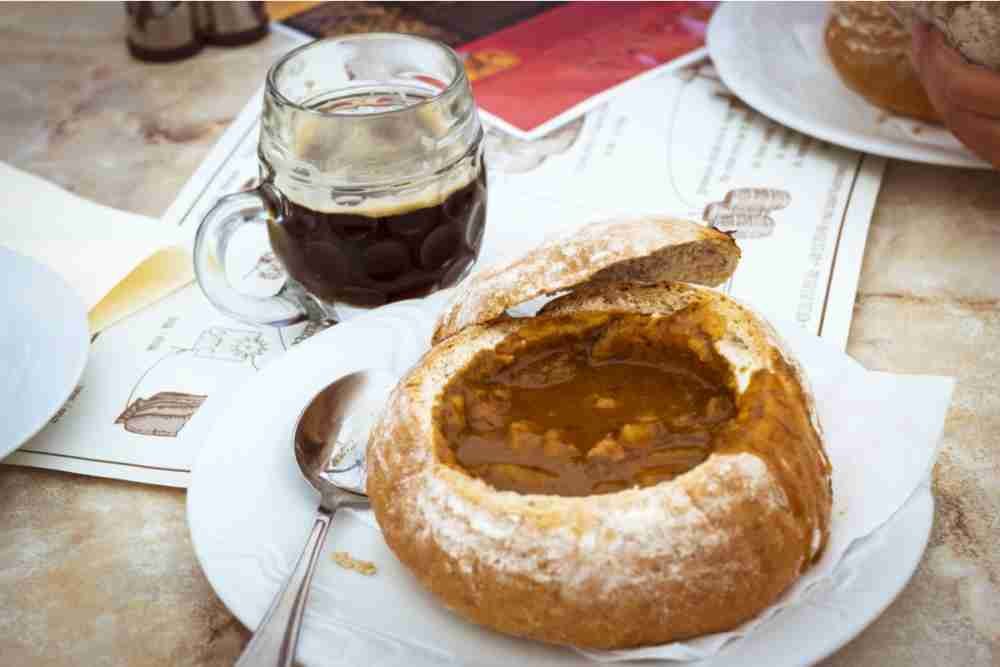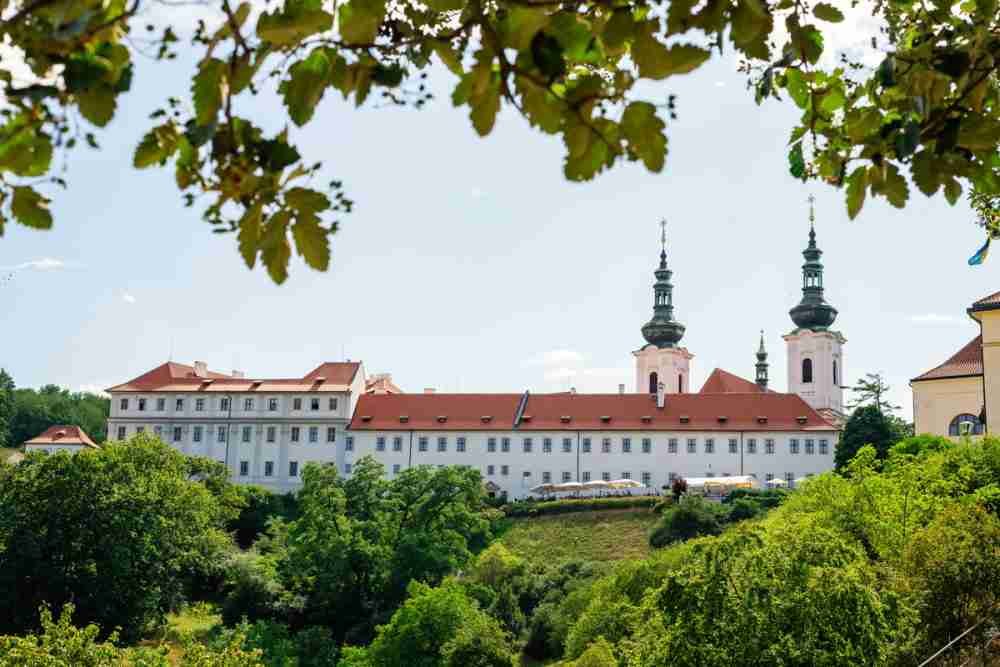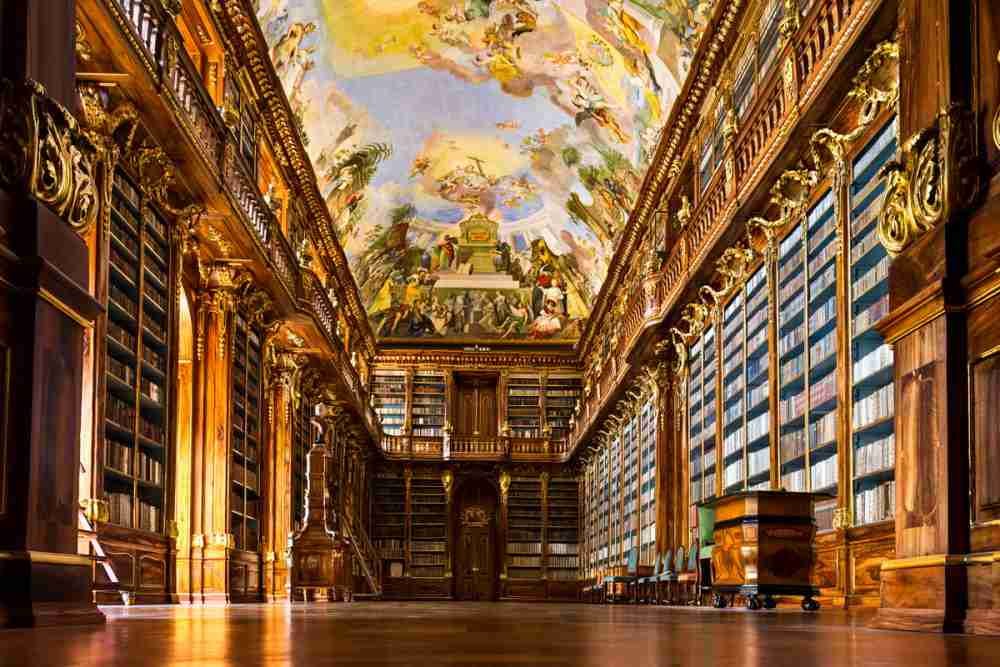Founded in 1143, Strahov Monastery is still inhabited by about 70 monks from the Premonstratensian Order.
It offers numerous attractions, which is why it is considered one of the most popular sights in Prague.
In this complete guide to Strahov Monastery, you'll learn all about the exhibition, history, and helpful information about directions and tickets.
What Can I Do at Strahov Monastery?

Library
The Strahov Monastery, located near Prague Castle, is particularly famous for its splendidly furnished Baroque library. It is considered to be one of the most valuable and best preserved historical libraries.
The monastery library contains over 200,000 volumes, 3000 original manuscripts from the Middle Ages, artifacts, first prints, manuscripts, and curiosities. It consists mainly of the following three halls.
Picture Gallery
Additionally, the monastery houses an important painting gallery with one of the most valuable monastery collections in Central Europe. The collections consist of about 1,500 paintings and other exhibits from the Gothic and Romantic periods.
The collections can be divided into the following sections.
- Painting and Sculpture between 1300 - 1500
- Rudolfin Paintings
- Flemish Paintings
- Central European paintings from the 17th to the 19th centuries
Treasury
The Treasury of Strahov Monastery presents a variety of different liturgical objects in a permanent exhibition. The exhibition includes unique handicrafts of Czech origin, as well as those from different parts of Europe. Visitors can admire, among other things, chalices, reliquaries, and vestments from the Middle Ages to the beginning of the 20th century.
Monastery Church of the Assumption of the Virgin Mary
The original Romanesque three-nave basilica of the Assumption of the Virgin Mary from 1148 is located in the center of the monastery. The Roman Catholic church acquired its present appearance, in the Baroque style, during reconstruction between the years 1742 to 1758.
Magnificent wall paintings and ceiling frescoes decorate the interior of the church. The founders of the monastery, Prince Vladislav II and Bishop Jindřich Zdík, were buried in an unknown place in the church.
In 1787, no less than Mozart is said to have played the organ in the monastery church.
St. Rochus Church
The second church in the area of the monastery is the Church of St. Roch. Visitors can find it in the forecourt of the monastery. The church, dedicated to St. Roch, the saint of the plague, was donated by Emperor Rudolf II in 1603 in gratitude for being spared from the plague. Since the 20th century, the former parish church has served as an exhibition hall.

Beer in the Monastery
Strahov Monastery is also home to a famous monastery brewery. The brewery has been brewing beer since the 13th century.
St. Norbert beer, named after the founder of the Premonstratensian Order, is produced here in various variations in this family business. There are also seasonal beer offerings, including a bock beer with a 6.3% alcohol content, which is served from the end of September, and the Easter beer with a 5.3% alcohol content, which is available on the Friday before Good Friday.
According to surveys, this monastery brewery produces the best beer in the whole Czech Republic. More about the best beer in Prague you can find in our list: Where can I drink good beer in Prague?

Beer Garden and Restaurant
The beer garden in the monastery attracts both locals and tourists from all over the world. It is the ideal place to taste famous Czech beer. The popular beer garden in the monastery is especially attractive when the weather is nice.
Equally popular is the restaurant in the monastery brewery, which is one of the top restaurants in Prague with Czech cuisine.

Admission, Tickets, and Guided Tours

How to Get to Strahov Monastery?
Strahov Monastery is located in the Hradčany district in Prague. It is located the Petrin Hill near the Prague Castle.
The best way to reach it from the city center is by streetcar line 22 to the Pohořelec station.

History of Strahov Monastery
Strahov Monastery was built in 1140 on Petrin Hill. The foundation of the Premonstratensian monastery took place through the cooperation of Olomouc Bishop, Henry Zdík, and Bohemian King, Vladislav II.
In 1142, a group of members of the Premonstratensian Order settled in the building and further expanded the area.
Over the centuries, the monastery withstood several battles, fires, and revolutions. The most devastating fire happened early in the history of the monastery, in 1258. A large part of the monastery, including the library as well as a church, fell victim to the fire.
Several repair and reconstruction works took place over the years. The monastery got its present appearance in the Baroque style during reconstruction in the 17th century. The magnificent baroque library dates from the time.
An absolute standstill came in 1950 with the communist occupation. For the first time since its foundation, the monks had to leave the monastery. Many were expelled or arrested, and the monastery itself was closed.
Only with the collapse of the communist regime in 1989, could the monks return to the monastery.
Even today the monastery is the seat of the Premonstratensian Order.

